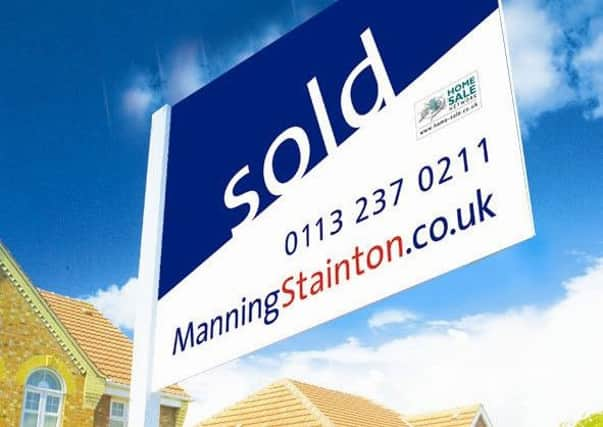Outlook bright for Yorkshire property prices


The latest Land Registry data reveals that houses prices in England fell by 0.6 per cent between September and October this year, but still showed an annual rise of 4.7 per cent taking the average property value to £240,860.
The East Midlands experienced the greatest increase over the last 12 months, up by seven per cent, while London saw the lowest, up by 2.1 per cent. The East Midlands and the South West had the biggest monthly price rise, both up by 0.2 per cent, and the North West saw the most significant monthly price fall, down by two per cent
Advertisement
Hide AdAdvertisement
Hide AdIn Yorkshire, prices were up 3.3 per cent year-on-year but saw a 1.1 per fall between September and October. The average house price in the region is now £155,281.
Sheffield topped the Yorkshire table with an annual rise of 7.8 per cent with Craven a close second at seven per cent. Calderdale saw a year-on-year fall of 1.2 per cent and Doncaster prices were also in the red by 0.1 per cent.
Annual increases in other local authority authority areas are as follows: Scarborough and Harrogate 6.8 per cent; Ryedale 6.5 per cent; North Yorkshire 5.6 per cent; Richmond 5.5 per cent; York five per cent; Barnsley, East Riding and Selby 4.4 per cent; Rotherham 4.2 per cent; Kirklees 3.9 per cent; Bradford 3.8 per cent; Wakefield 3.7 per cent; Leeds 2.6 per cent.
Lack of supply, a common theme throughout this year, is highlighted in the most up-to-date Land Registry sales figures available for England, which show the number of completed sales in August 2017 fell by 12 per cent to 70,117 compared with 79,655 in August 2016.
Advertisement
Hide AdAdvertisement
Hide AdIn Yorkshire, Craven, which includes Skipton and parts of the Yorkshire Dales, saw the biggest fall of 22 per cent, followed by Leeds with a drop of 20.6 per cent.
The average price for a detached house in England in October was £367,156, a semi was £223,823, a terraced house was £192,376 and a flat was £225,974.
Detached homes were the best performers year-on-year, seeing an average seven per cent rise in values. Semis saw an average 5.2 per cent increase, terraced houses climbed by an average 4.1 per cent, leaving flats bottom of the table with a 3.6 per cent rise.
The latest repossession sale figures from the Land Registry cover September and saw Yorkshire with 99, the second highest number, only slightly behind the North West. The East of England had the lowest with just 10 homes repossessed.
Advertisement
Hide AdAdvertisement
Hide AdMeanwhile, Home.co.uk has published its asking price index and says that the London property slump continues to drag the national growth figure down, masking wide variations across the country.
The index shows an average growth in asking prices this year of 2.6 per cent in England and Wales. London has a one per cent fall and Yorkshire a 4.7 per rise - the third highest increase behind the West Midlands, six per cent, and East Midlands, 6.4 per cent.
Doug Shephard, Director of Home.co.uk, says there are signs that Yorkshire and the North West will become the leading regions for price growth towards the end of 2018, as “property remains relatively affordable in these regions and buy-to-let yields are attractive.”
Seasonal trends come into play at this time of year and month-on-month declines are the norm. Over the last month asking prices fell in all of the nine English regions and in Scotland but not Wales.
Advertisement
Hide AdAdvertisement
Hide AdInconsistent with seasonal expectations is a jump in new listings of property for sale. They showed an 11 per cent growth last month compared with the same time last year.
Doug Shephard says: “Should the trend continue, we warn that such a rapid rise in supply would lead to rising stock levels as demand becomes overwhelmed. Such an event would transform the current benign stagflationary conditions into a destabilising deflation in home prices.”
Home.co.uk’s data on the lettings market shows a marked decline in the number of available rental properties, which suggests that landlords may be exiting the buy-to-let sector. Doug Shephard says: “Such has been the rapid increase in taxation and regulation in the sector, this would hardly be surprising.”